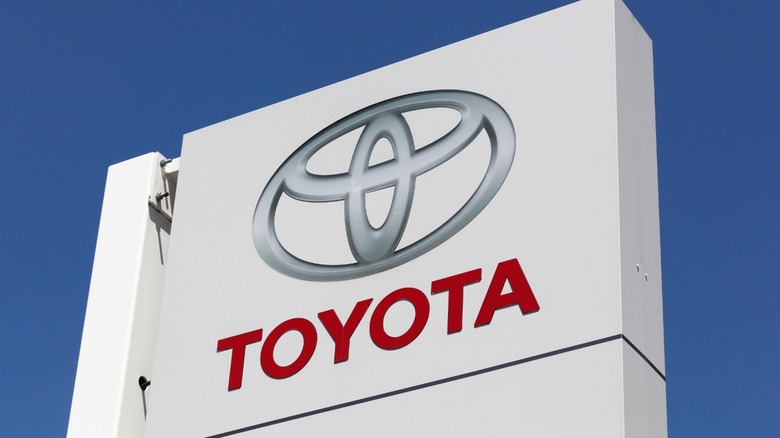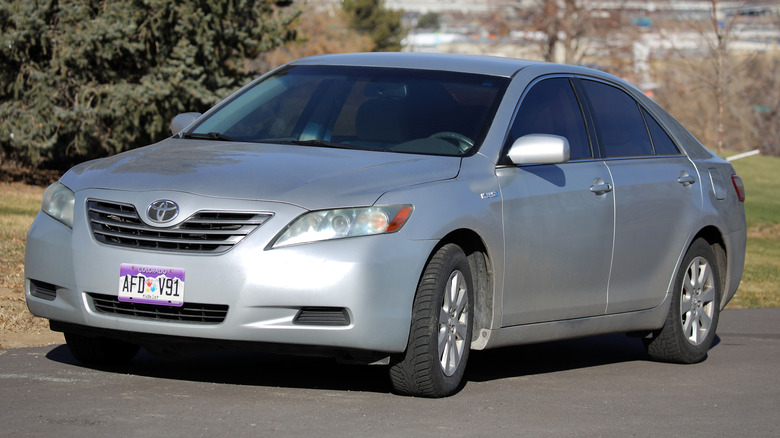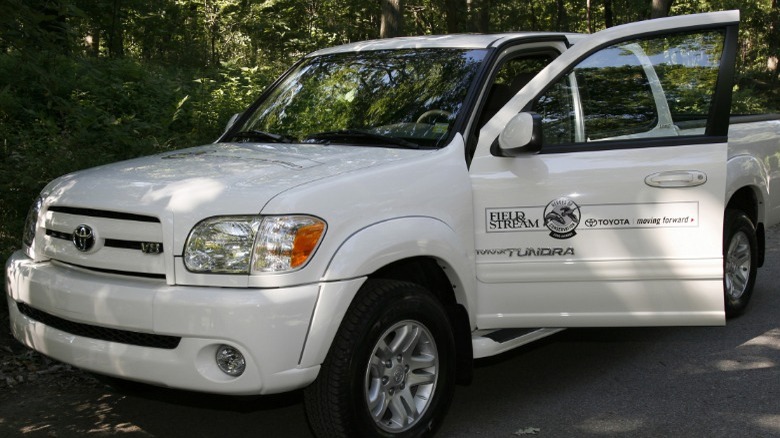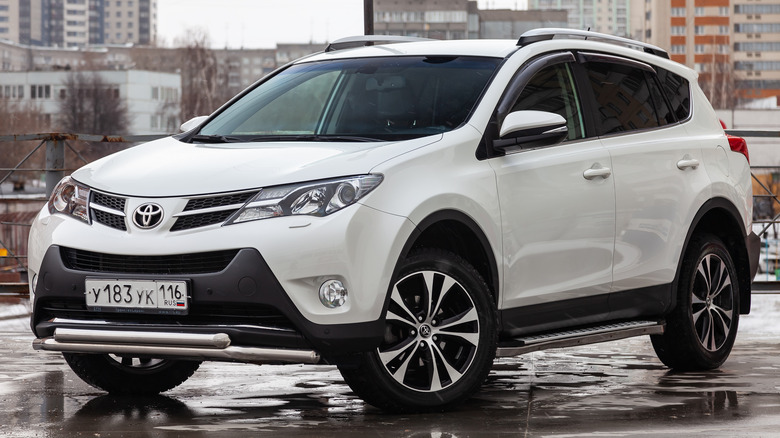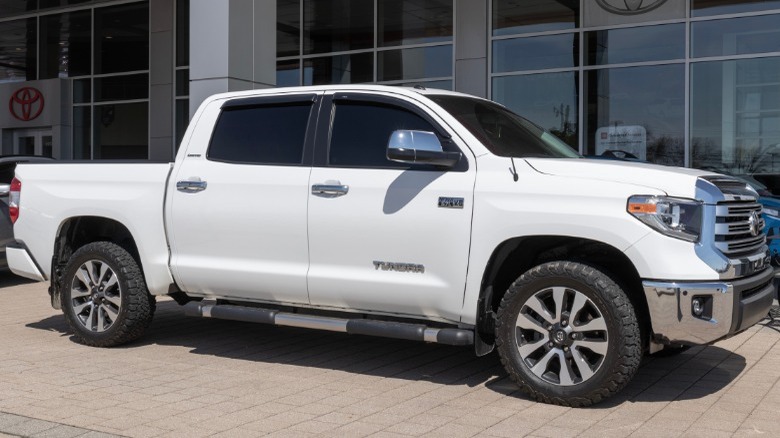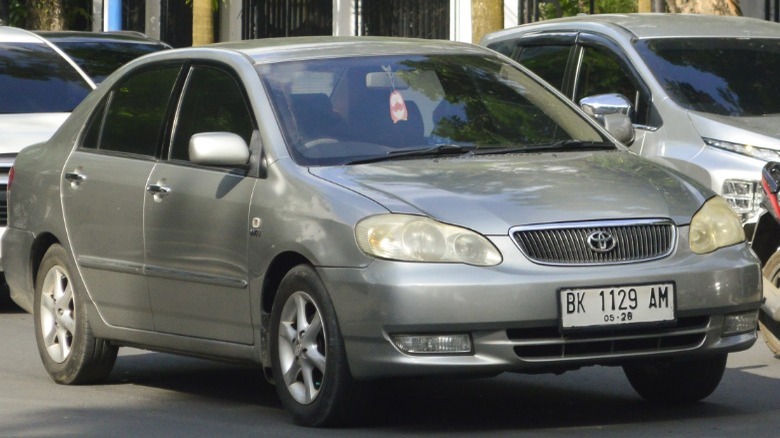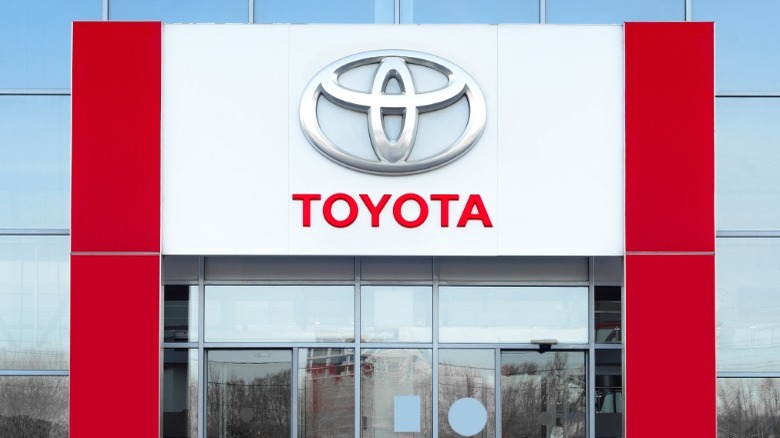The 5 Worst Toyota Recalls You Need To Know About (Especially If You Own One)
Toyota is known for building vehicles that are immensely dependable, efficient, and powerful without exorbitant price tags. Some of the most reliable Toyota cars ever built include popular models like the Toyota Tundra, Toyota Sienna, and the timeless Toyota Camry. But for everything that's great about Toyota vehicles, there are also a few things that aren't so great.
Recalls, in particular, have plagued the automaker at various points in its history. In the past 20 years alone, Toyota has been forced to recall millions of its cars around the globe. Unfortunately, most of those recalls were issued for pretty serious defects and mechanical flaws. Many of us are familiar with the infamous Takata airbag malfunctions, and lots of us have probably been affected by one of the resulting recalls. But despite the severity of that particular issue, it's not the worst recall that Toyota has ever issued or been a part of. In reality, Toyota, like virtually every other automaker, has been involved in various recalls. While this information may seem boring or overly negative, it's important to pay attention to vehicle recalls, especially if you own one of the affected cars.
As a former mechanic who previously worked as a flat-rate repair tech for a large Toyota dealership, I'll help you understand some of the most serious Toyota recalls and the approved fixes. That way, if you don't own one of these cars, you can rest easy. But if you do own one, you'll know exactly what the problem is and how to go about getting it fixed. So, from faulty gas pedals to malfunctioning airbags, these are the worst Toyota recalls you need to know about.
Unintended acceleration recall
One of the worst Toyota recalls in the manufacturer's history took place between 2009 and 2011 and affected nearly 8 million cars in the United States and more than 9 million vehicles worldwide. The recall was triggered by a series of deadly accidents involving Toyota cars. The ultimate source of the problem was a combination of two issues: improperly secured/poor fitting floor mats and defective gas pedals.
Toyota's gas pedal and floor mat woes actually started in 2007, when the National Highway Traffic Safety Administration (NHTSA) began investigating the company after a series of deaths and crashes caused by stuck accelerator pedals. The government agency determined the source of the problem to be faulty floor mats and ordered the automaker to recall 55,000 Toyota Camrys and Lexus ES350s with model years between 2007 and 2008. While that should have been the end of Toyota's acceleration pedal problems, the issue, unfortunately, didn't end there.
The real headache for Toyota began in 2009. A fatal crash involving a 2009 Lexus ES350 — a vehicle built after the original recall — prompted the NHTSA to reopen its investigation into Toyota. The agency discovered that Toyota continued to knowingly build vehicles with defective and dangerous components. As a result, the NHTSA ordered Toyota to recall not only the floor mats but also the gas pedals for affected vehicles and to pay various multi-million dollar fines. Between 2009 and 2011, Toyota recalled nearly 8 million vehicles in the United States alone. As one of the most severe recalls in automotive history, the problem impacted various Toyota cars, trucks, and SUVs produced between 2003 and 2011, and Toyota was ultimately forced to pay a $1.2 billion settlement for its attempt to hide the problem from the public.
Power window switch recall
Another was actually a series of two recalls issued in 2012 and 2015, potentially affecting over 4 million vehicles in total. According to reports by the NHTSA, affected vehicles were built with a driver's side power window master switch that uses a spray-on grease to provide lubrication to the sliding electrical contact modules. The report states that the grease may have been applied incorrectly or unevenly, resulting in increased contact, friction, and wear during normal operation. That friction and wear can lead to short circuits, causing electrical damage and even fires.
The first recall, issued in 2012, covers a potential 2.5 million vehicles with model years between 2007 and 2009. The 2015 recall increased that number by nearly 2 million and affects various vehicles with model years between 2006 and 2011. Affected models include the Tundra, Sequoia, Camry, Camry Hybrid, Corolla, Matrix, Scion xB, Highlander, Highlander Hybrid, RAV4, Yaris, Scion xD, and Pontiac Vibe. As stipulated in the recall, Toyota will contact known owners of vehicles meeting the above specifications to encourage them to visit a dealership for an inspection and repair if applicable. If the dealership discovers a problem, Toyota will replace the power window master switch circuit board free of charge. If Toyota does not find an issue, the dealership will apply a fresh coating of lubricant designed to prevent future heat build up.
RAV4 battery recall
Not all of the worst Toyota recalls affect various models. The automaker issued another one of its most severe recalls in 2023, potentially involving nearly 2 million RAV4s with model years between 2013 and 2018. The recall was spurred by the discovery that these vehicles were built with battery trays and tie downs that don't fit many aftermarket batteries. That's a substantial problem because most 12-volt car batteries only last for three to five years, meaning owners must replace the stock battery after a period of ownership.
The issue is that the original battery tray and tie down were designed to fit a specific type of battery that Toyota installs in its new vehicles. When owners replaced the original battery with a new one, many discovered that the stock equipment was unable to secure their new battery. That's a dangerous problem, as an unsecured battery can jostle and move around while you drive, leading to things like short circuits and fires.
The NHTSA report says that Toyota will contact all known owners of affected vehicles, instructing them to visit a dealership for a free repair. The automaker will replace the faulty battery tray, tie down, and positive terminal cover with improved equipment at no cost to the owner. Additionally, if owners have already paid to have this service performed by a third-party repair shop, Toyota encourages owners to seek reimbursement through the company's General Reimbursement Plan.
Automatic transmission recall
One of Toyota's more recent recall disasters took place in February 2024. The NHTSA ordered the automaker to recall a potential 280,663 vehicles due to malfunctioning automatic transmissions. Affected cars were built with defective transmission brake clutch plates that fail to disengage when drivers shift into neutral. The issue allows small amounts of engine power to reach the wheels, resulting in vehicles that may creep forward and cause accidents and injuries when they are supposed to be stationary.
Unlike other recalls, this problem only affects four vehicles: 2022-2024 Toyota Tundras, 2022-2024 Toyota Tundra Hybrids, 2023-2024 Toyota Sequoia Hybrids, and 2022-2024 Lexus LX600s. The NHTSA ordered Toyota to repair affected vehicles by updating the transmission control module software responsible for actuating brake clutches and other internal transmission components. Owners are not responsible for paying for the fix, and the repair is covered under Toyota's warranty. The recall information released by the NHTSA states that not every potentially affected vehicle was sold in the United States, and that Toyota is unable to say for certain what percentage of the cars meeting the above model specifications are at risk.
The report goes on to say that Toyota will contact every known owner of vehicles containing the defective transmission prior to April 21, 2024. The key word here is known. It's important that owners of Toyota cars meeting the above specifications reach out to their local dealership or use the automaker's online VIN checker — which we will describe in greater detail later — to determine if their vehicle is at risk.
Takata airbag recall
While not limited to Toyota, numerous Toyota vehicles are affected by one of the worst recalls in automotive history: the Takata airbag inflator recall. It can be difficult to differentiate between the various airbag recalls that Toyota has issued over the years. The company has recalled millions of cars throughout the past decade for defective airbags. However, the Takata recall is one of the worst ever and affects a huge amount of Toyota, Lexus, and Scion vehicles.
The problem is caused by defective inflators that can rupture when the airbag deploys. When the inflators explode, they can send shrapnel flying into the cabin at extremely high speeds, causing potentially severe injuries and death. Overall, 19 automakers have been affected by faulty Takata airbags and tens of millions of vehicles have been recalled. Toyota itself has recalled hundreds of thousands of cars for this issue and just recently released a "Do Not Drive" advisory for 50,000 additional models, including certain 2003-2004 Corollas, 2003-2004 Corolla Matrixes, and 2004-2005 RAV4s. Outside of the 2024 "Do Not Drive" advisory, various other Toyota vehicles are subject to Takata recalls, including but not limited to 2003-2006 Tundras, 2002-2007 Sequoias, 2011-2014 Siennas, and more.
As with other recalls, Toyota will contact known owners, encouraging them to visit a dealership for a free fix. The repair involves removing the defective inflator and installing a functioning replacement. Out of all of the mechanical defects covered here, the Takata airbag issue is one of the most dangerous. As of 2024, defective Takata airbag inflators have been responsible for 27 deaths and more than 400 injuries.
How to find out if your Toyota is affected by a recall
We've covered five recalls here, but Toyota has issued hundreds of recalls covering millions upon millions of vehicles. Considering that and the severity of many of the issues that have prompted these recalls, it's vital that Toyota owners know whether their car is affected. Failing to address a recall can have disastrous results, including serious injury or even death.
Luckily, finding out whether or not there are any active recalls for your car is pretty simple. First of all, any time that Toyota issues a recall, it will contact all known owners of affected vehicles. However, if you buy your vehicle used or forget to change your address after moving, you may not receive that notification. In that case, you can visit Toyota's recall lookup portal to search specifically for any active recalls or service campaigns applying to your car.
All you need is your license plate number or vehicle identification number (VIN) to check your vehicle, and Toyota encourages owners to recheck the portal every three months to stay ahead of new recalls. The portal will display any active safety recalls or service campaigns dating back to 1999, and it displays data for Toyota, Lexus, and Scion vehicles sold in the United States, U.S. territories, and Mexico. If there is an open recall for your car, don't worry. Simply reach out to your local dealership and set up a time for the repair. Toyota will not charge you for repairs required due to safety recalls, and addressing the issue can help you avoid serious or even deadly consequences.
